|
|
Film projectors and slide projectors, part 1. |
|
When is a projection device still a
magic lantern and when should we start talking about projectors ? The dividing line is not
easy to draw. Of course the tin lanterns with a small oil lamp from Bing and
Plank are without any doubt real magic lanterns and we will
certainly not characterize a relatively modern film projector like the Eumig P8
as a magic lantern, but there is a large gray area in between. For that reason I would certainly not call the projectors on this page real magic lanterns and they are therefore on the upper limit of my collection area, but still they are often fun, touching, interesting, special and you name it. Hence this page. But it should not become much more modern. |
|
Diafant 0. Made by Ed.
Liesegang.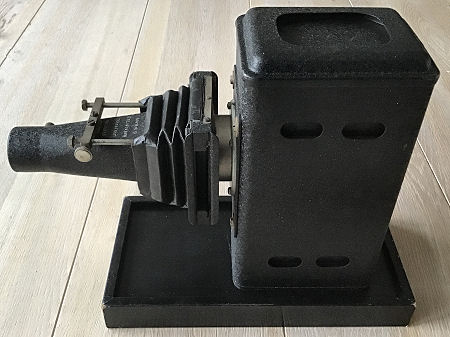 |
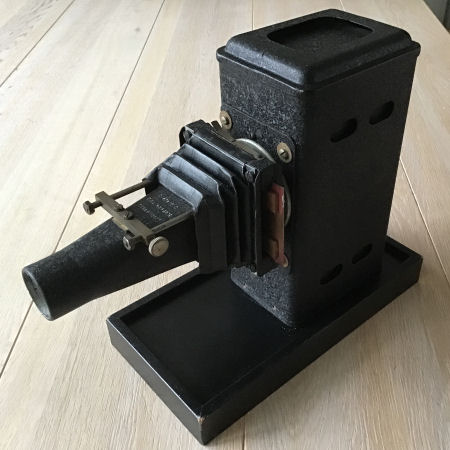 |
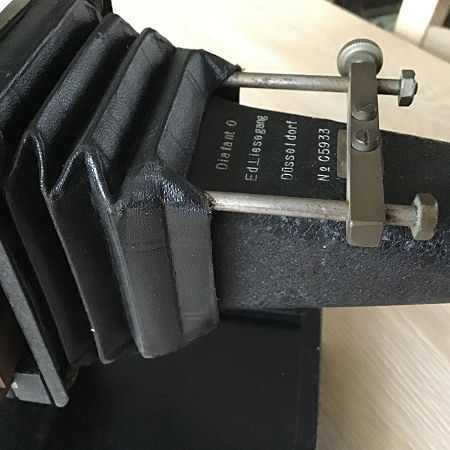 |
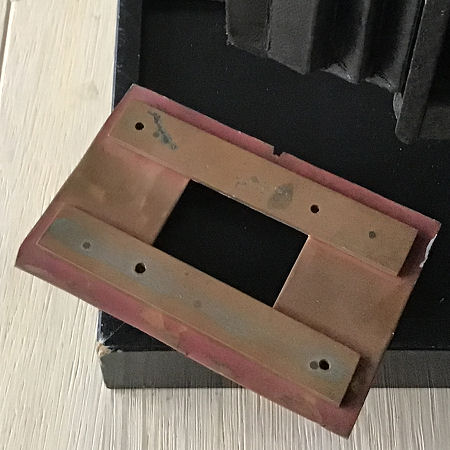 |
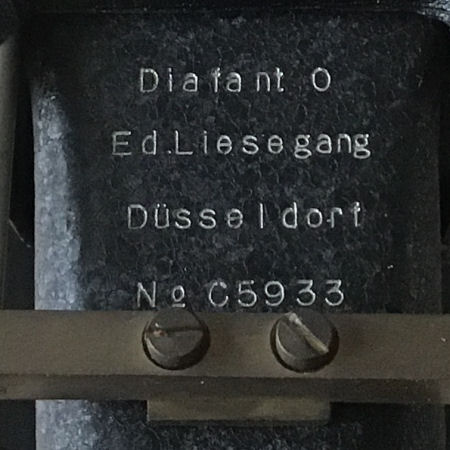 |
Presumably the first 35mm slide projector, produced
in 1931 by Ed Liesegang, Düsseldorf. Lens: Parastigmat S III 1:4.5. The
entire optical system can rotate 360 degrees. Found in the thrift store. The basic plank was missing. That was the reason to put the projector back after many doubts. The next day I deeply regretted it and went back to the thrift store. Unfortunately, the lantern was missing and apparently sold. About six weeks later this lantern suddenly appeared on the shelves again. Now with a blue label that indicated that the device was sold for half the price that week. It was now evident... this special projector was clearly intended for me. Special, yes, because to my knowledge this projector is the only one in this category that is equipped with an extendable bellows. You usually only find this in the much larger projectors. There was also an adapter for mounting the slides, which looks rather primitive, but is probably original. In another thrift store I found a container or drawer that could serve as a base for the lantern. With some tinkering I was able to unite the two. |
FAFIX slide projector. |
|
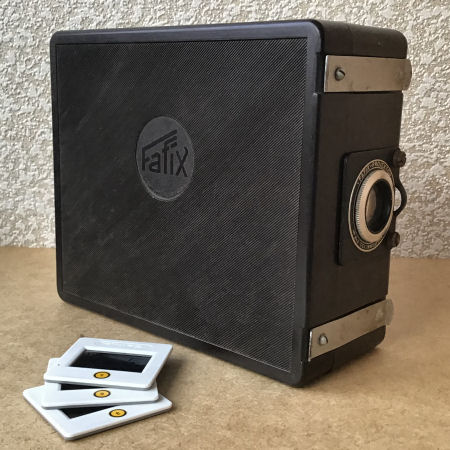 |
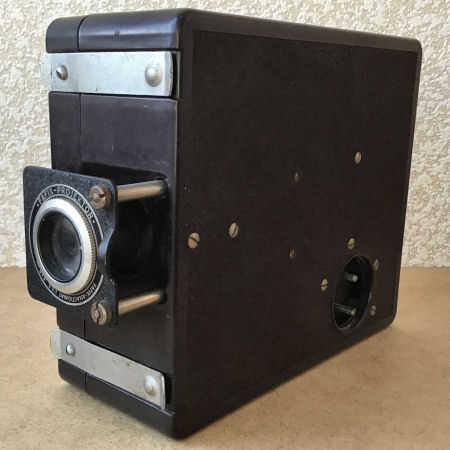 |
 |
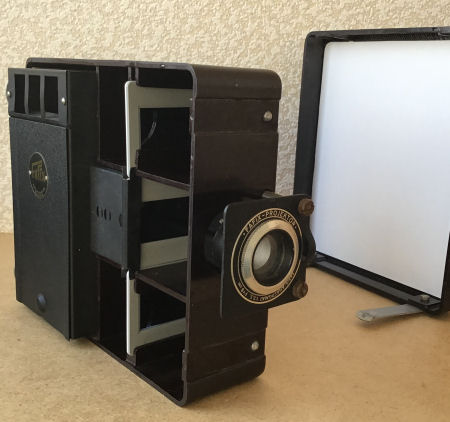 |
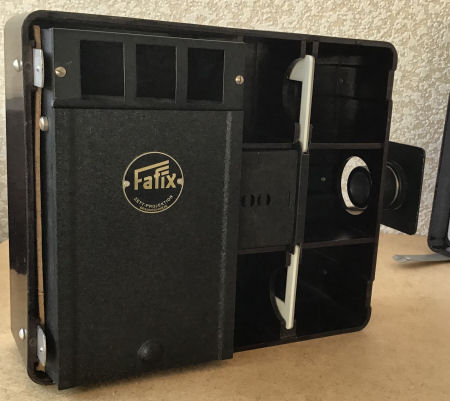 |
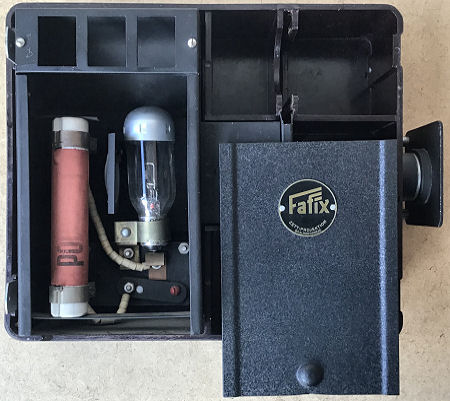 |
 |
The Fafix slide projector is a very simple projector that at first glance
looks like a lunch box with a lens built into one of the sides.
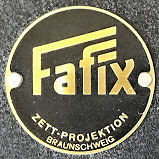 The lid
must be removed to use the projector. We then see the lamp house, some
compartments for storing slides, a slide transport system and the projection
lens, which must be extended. The transport system comprises two slots;
the new slides are pushed into the top one, the slides already shown can be
taken from the bottom slot. The slide being projected is located between
these two slides. The inside of the lid is equipped with a white
cardboard that serves as a projection screen. The lid
must be removed to use the projector. We then see the lamp house, some
compartments for storing slides, a slide transport system and the projection
lens, which must be extended. The transport system comprises two slots;
the new slides are pushed into the top one, the slides already shown can be
taken from the bottom slot. The slide being projected is located between
these two slides. The inside of the lid is equipped with a white
cardboard that serves as a projection screen.The Fafix is made of bakelite. The dimensions are approximately 19 x 8 x 16.5 cm. The device was manufactured by Zett-Projektion Braunschweig, a photo-technical company that was founded by Erich Zillmer. From 1957 the entire production was continued by Voigtländer. The device was manufactured by Zett-Projektion Braunschweig, a photo-technical company founded by Erich Zillmer. From 1957 the entire production was continued by Voigtländer. |
| This projector was later succeeded by the Fafix II, a somewhat more luxurious version with a 'normal' slide transport, among other things. This projector is also made of bakelite, size c. 20 x 8 x 17 cm. | |
 |
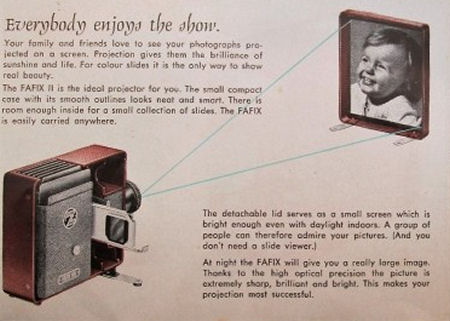 |
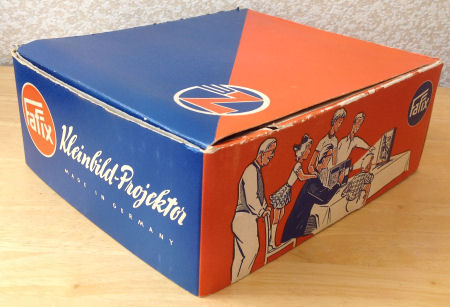 |
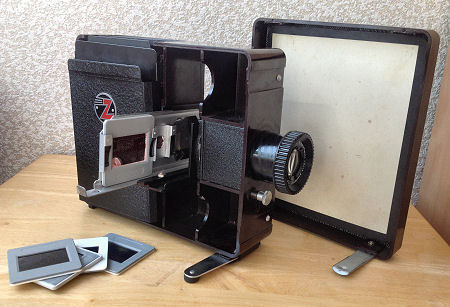 |
 |
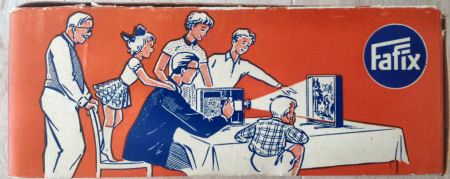 |
| The Fafix II is packed in a colourful cardboard box with some cosy living room scenes on two sides. | |
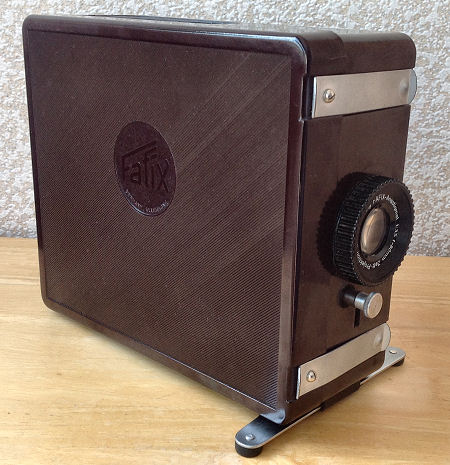 |
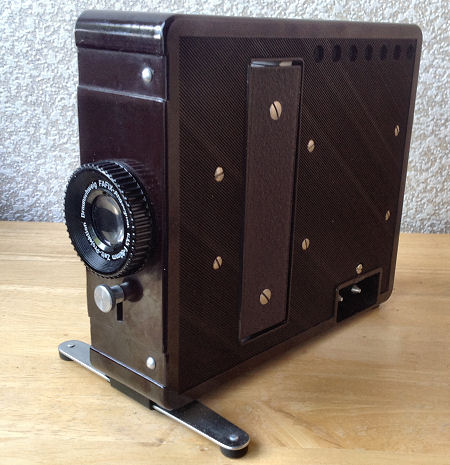 |
| At first glance, the Fafix II does not differ much from its predecessor. Upon closer consideration, the differences stand out. The height-adjustable supports against falling over, a 'normal' adjustable objective, the mains plug and, as the most significant difference, an elongated hatch in the side wall. | |
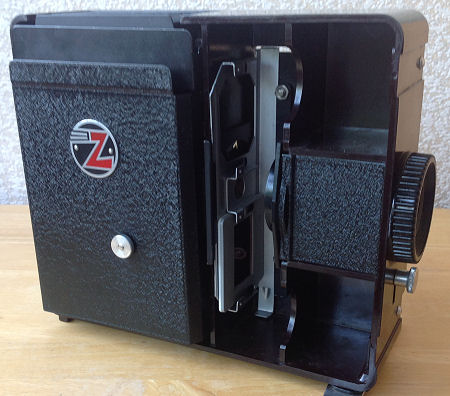 |
 |
| When the lid is removed, we see the slide carrier, which in the unused state is folded vertically upwards. The slide carrier is mounted on the hatch in the side wall and can be tilted to a horizontal position. | |
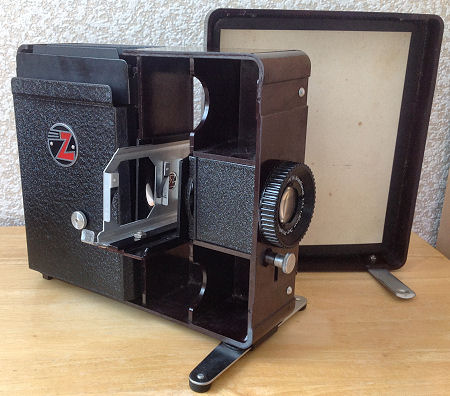 |
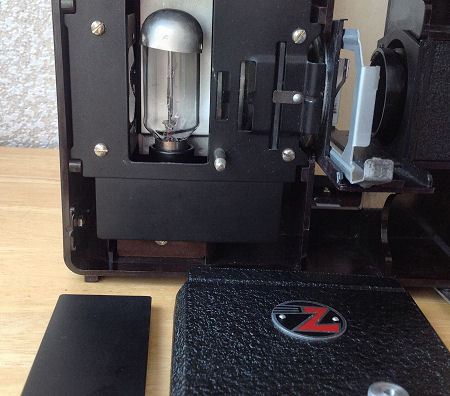 |
|
The white inside of the lid can be used as a
projection screen just like its predecessor. Zett's trademark is only visible when the lid is removed. |
When two metal cover plates are removed, the projection lamp becomes accessible. Between the lamp and the slide is a glass heat filter, held by a clip. |
| Camerafix slide projector. | |
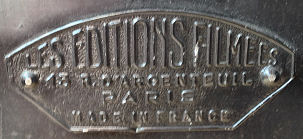 The large leather handle on top of the device shows that this projector is also made for mobile use. The manufacturer is the French company Les Editions Filmées, based in Paris. The version is reminiscent of the Fafix projector, but the Camerafix projector has no fewer than four doors, two at the front to control the slide transport and two at the rear for changing and adjusting the 220 Volt projection lamp. |
|
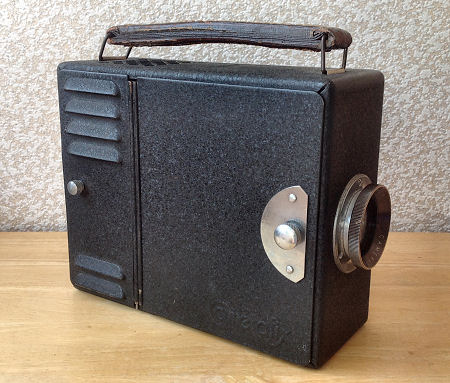 |
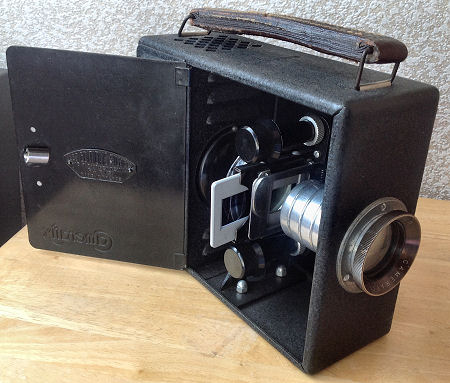 |
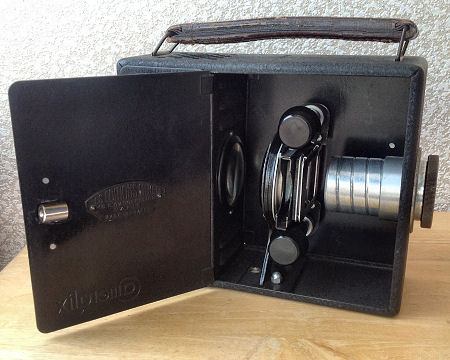 |
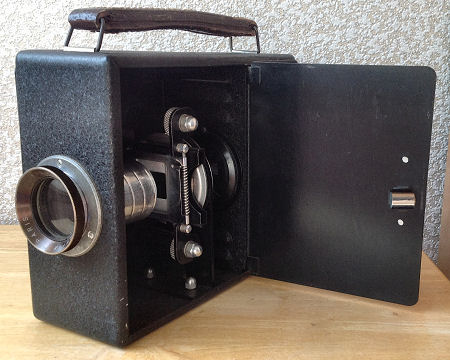 |
| A small metal plate with the name and address of the manufacturer is placed on the inside of one of the doors. In addition to the carrier for the slides, there are two rolls below and above it that can be used to display a film strip. | |
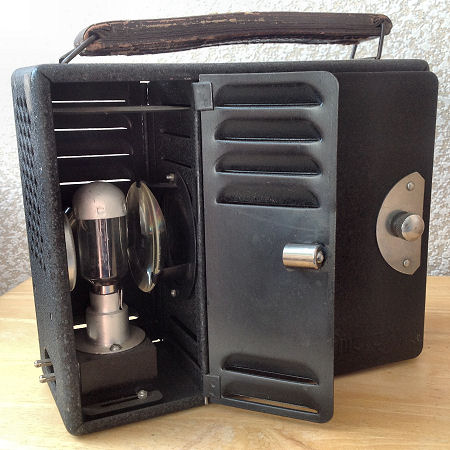 |
The lamp housing contains a lamp, a reflector and a
condenser lens. All four doors are closed with a snap closure. There is
a threaded hole in the bottom that allows the projector to be mounted on a tripod. The projector is quite heavy, three kilos, due to its metal body. Lens: Camerafix Paris 1 / 2.9. The dimensions of this projector are approximately 22 x 9.5 x 18 cm, incl. lens and buttons, but without the handle. |
|
Pathé Baby 9,5 mm
film projector. In 1922, Charles Pathé released the Pathé-Baby, a small projector made for domestic use. His company had already made a home projector, the Pathé Kok, which came out in 1912, but this 28 mm projector was difficult to handle and proved too cumbersome for many to use in the home. To solve this problem, Pathé invented a new film format, the 9.5 mm film, the most compact format that would ever be used, until Kodak released the 8 mm film in the 1930s. In many ways the 9.5 format is better than the 8 mm film, but eventually Pathé lost the battle and 8 mm became the standard. |
|
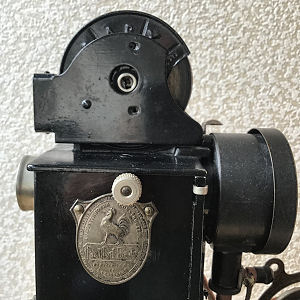
The projector is made of black painted metal. At the very top of the projector is the cassette holder, in which a cassette with film is placed. This holder is provided with a crank with which the played film can be rewound. There is no normal collection reel; the film is collected in a round room, closed with a removable glass window. A large resistor has been placed in the open foot of the projector, which reduces the 110 Volt mains voltage to a low voltage for supplying the projection light. A metal plate on the side indicates: "Etching CONTINSOUZA CONSTRUCTEURS PATHÉ BABY breveté and tous pays" and shows the rooster, the trademark of Pathé. |
|
 |
 |
| The Pathé Baby without electric motor.... | |
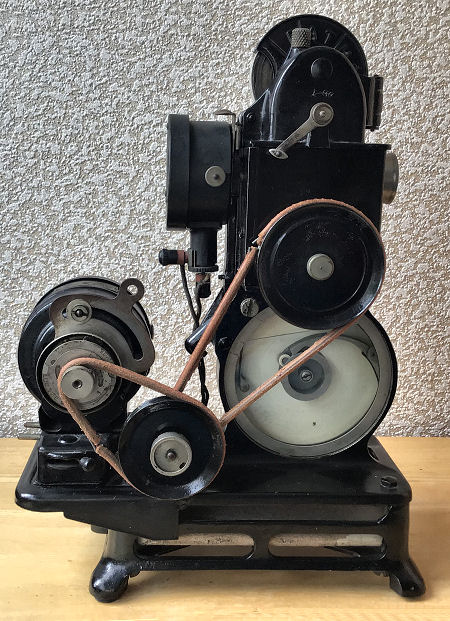 |
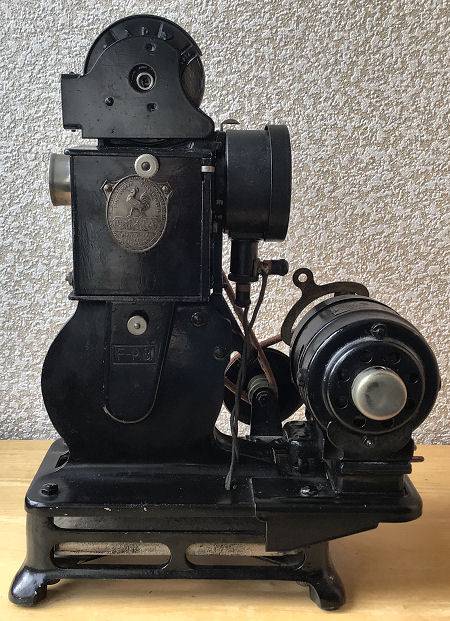 |
|
...... and the Pathé Baby with motor. The engine block is plugged complete with mains plug, switch, speed control and pulleys onto the mains plug already present on the projector. Of course, the existing crank must also be replaced by a wheel disc. Rubber strings drive the film transport. |
|
 |
|
|
The perforation is located in the mddle of the film,
on the dividing line between two frames. Because of this the image area is much larger than with Kodak, and the image quality therefore approximates that of the 16 mm film format. It is sometimes mentioned as a drawback that the frames could be damaged more quickly by the gripper during film transport. A very special facility of this projector is the delayed display of the intermediate titles between the moving images. As usual with silent films, the dialogues and the like were represented in a text. This took up a lot of space, because for 5 seconds of text, at a projection speed of 16 images per second, almost a hundred identical images were needed and longer texts needed many more images. The Pathé Baby films are provided with notches beside the interim titles and during projection a little catch falls into such a notch. This triggers a delay mechanism whereby the film transport is stopped for a few seconds. After that the film continues as usual. For longer texts, several intermediate titles and notches are used, because the film could burn if it is left at the same position too long. A brilliant system that saved many meters of expensive film! |
|
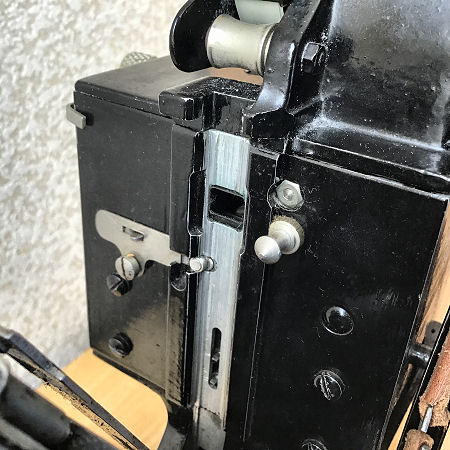 |
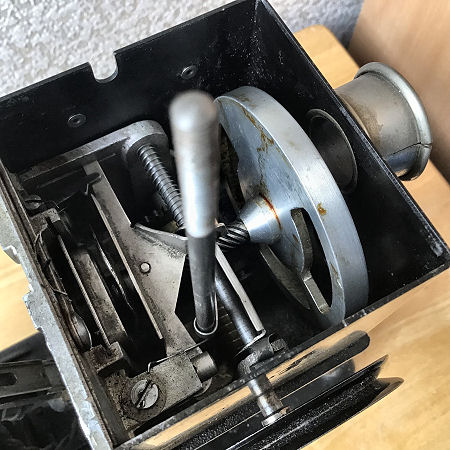 |
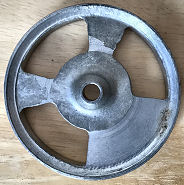 The
delay mechanism. We also see here the flywheel
that ensures an even film transport and also serves as a rotating
shutter by constantly interrupting the light beam when the film is being
transported. This flywheel is the most vulnerable
part of this projector. It is made of a metal alloy
that did not stand the ravages of time. In almost all
the Pathé Baby projectors that still exist today, the flywheels are
distorted and, because they are placed very tightly in the housing, get
stuck, making it no longer possible to transport the film. The
delay mechanism. We also see here the flywheel
that ensures an even film transport and also serves as a rotating
shutter by constantly interrupting the light beam when the film is being
transported. This flywheel is the most vulnerable
part of this projector. It is made of a metal alloy
that did not stand the ravages of time. In almost all
the Pathé Baby projectors that still exist today, the flywheels are
distorted and, because they are placed very tightly in the housing, get
stuck, making it no longer possible to transport the film. To insert the film, the part with the round lamp housing must be swung open and then closed again. |
|
| ALEF 9,5 mm filmprojector 'Bilcin'. | |
|
The ALEF 9.5 mm film projector Bilcin was made around
1930 by the German manufacturer A. Lehmann, Fuerth / Bayern. The company
produced a number of magic lanterns and projectors under the trade name
ALEF. Although this projector is of good quality on many points, there are also some negatives, such as the small lamp house with the consistent small bulb lamp, the small diameter of the lens and the limited size of the film reels that can be placed. |
|
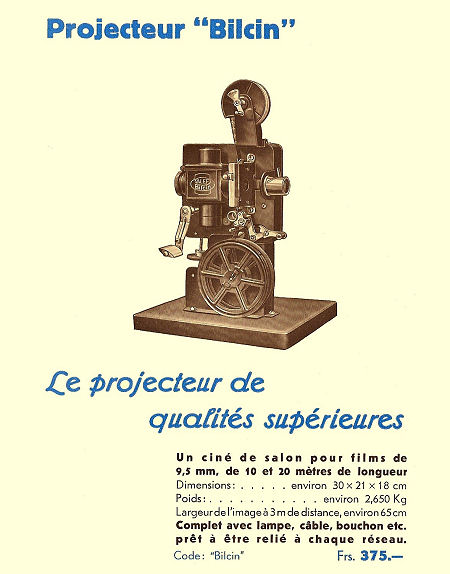 |
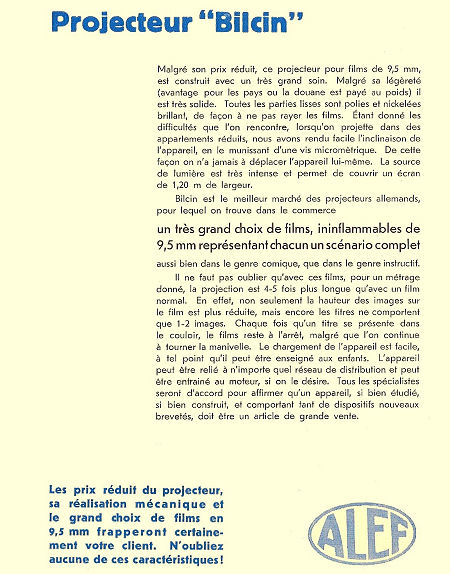 |
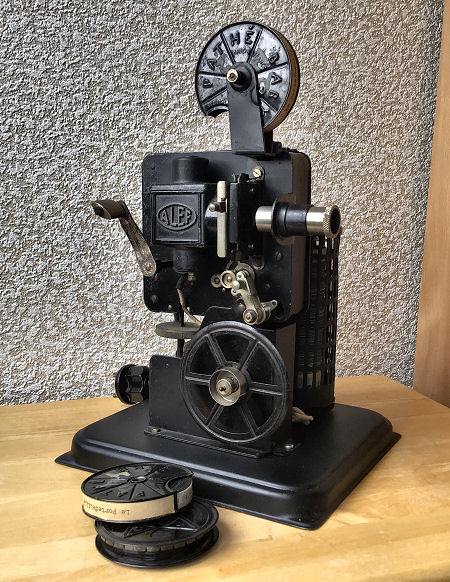 |
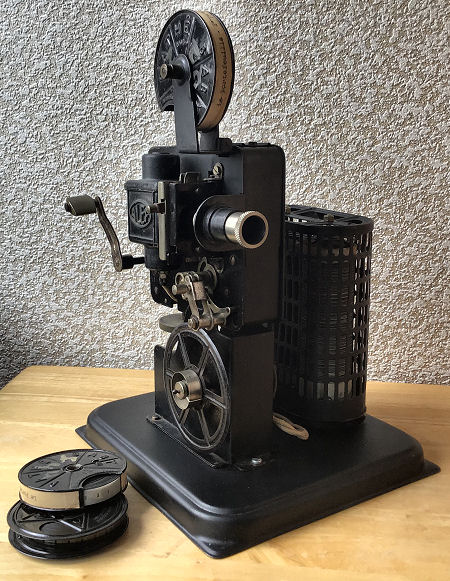 |
| The projector is made for playing 9.5 mm films, a format that was also used by Pathé for her Baby, among other things. Just like the Pathé Baby, this projector has a pause system for notched films. It is certainly nice that the well-known cassettes of the Pathé Baby can also be placed in the spool holder of the ALEF projector. | |
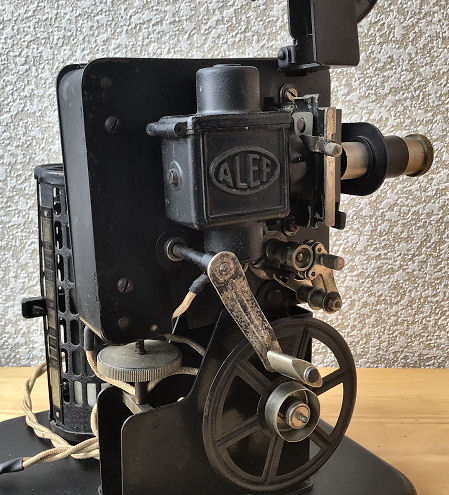 |
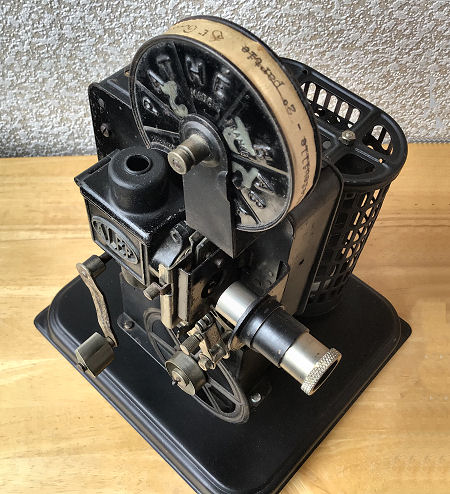 |
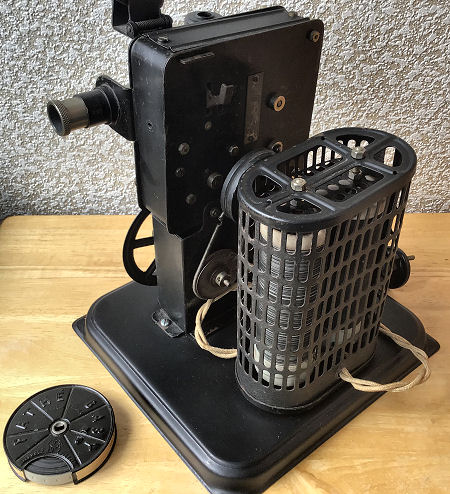 |
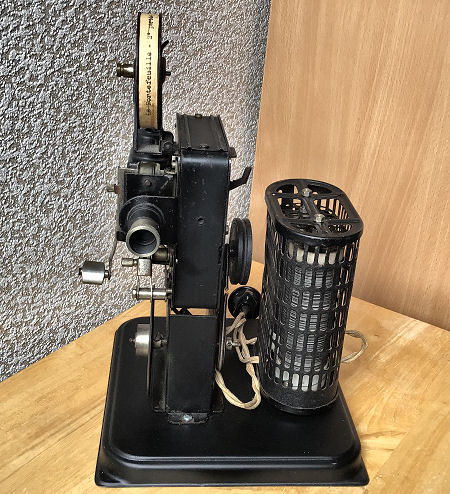 |
| Two large resistors are placed next to the projector. With the help of a slider, the projector can be adjusted to the local mains voltage. The electric current is only used for the light bulb (25 V, 25 W); the film is transported by turning the crank. | |
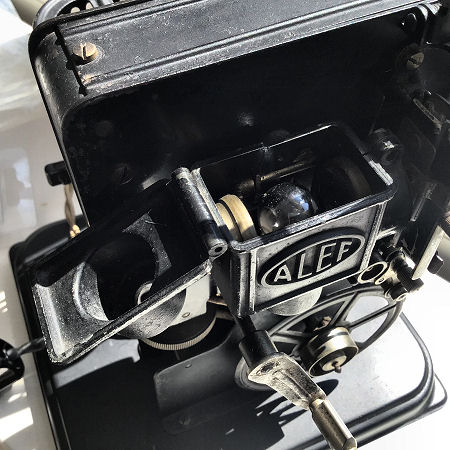 |
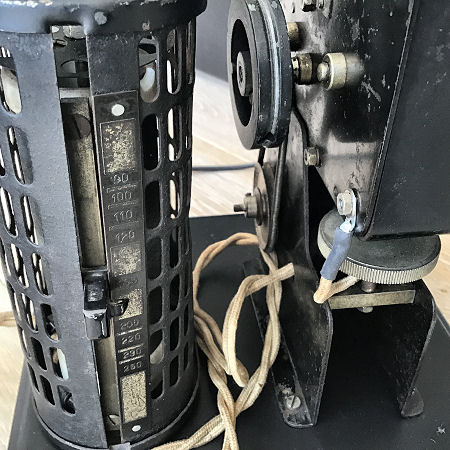 |
|
|
More projectors. |
| |
©1997-2024 'de Luikerwaal' All rights reserved. Last update: 12-03-2024. |
|